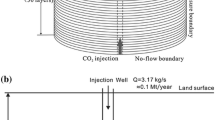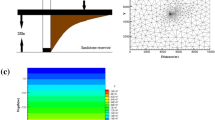Abstract
One of the uncertainties in the field of carbon dioxide capture and storage (CCS) is caused by the parameterization of geochemical models. The application of geochemical models contributes significantly to calculate the fate of the CO2 after its injection. The choice of the thermodynamic database used, the selection of the secondary mineral assemblage as well as the option to calculate pressure dependent equilibrium constants influence the CO2 trapping potential and trapping mechanism. Scenario analyses were conducted applying a geochemical batch equilibrium model for a virtual CO2 injection into a saline Keuper aquifer. The amount of CO2 which could be trapped in the formation water and in the form of carbonates was calculated using the model code PHREEQC. Thereby, four thermodynamic datasets were used to calculate the thermodynamic equilibria. Furthermore, the equilibrium constants were re-calculated with the code SUPCRT92, which also applied a pressure correction to the equilibrium constants. Varying the thermodynamic database caused a range of 61% in the amount of trapped CO2 calculated. Simultaneously, the assemblage of secondary minerals was varied, and the potential secondary minerals dawsonite and K-mica were included in several scenarios. The selection of the secondary mineral assemblage caused a range of 74% in the calculated amount of trapped CO2. Correcting the equilibrium constants with respect to a pressure of 125 bars had an influence of 11% on the amount of trapped CO2. This illustrates the need for incorporating sensitivity analyses into reaction pathway modeling.






Similar content being viewed by others
References
Allen DE, Strazisar BR, Soong Y, Hedges SW (2005) Modeling carbon dioxide sequestration in saline aquifers: significance of elevated pressures and salinities. Fuel Process Tech 86:1569–1580
Appelo CAJ, Postma D (2007) Geochemistry groundwater and pollution, 2nd edn. A.A. Balkema Publishers Leiden, London, p 649
Audigane P, Gaus I, Czernichowski-Lauriol I, Pruess K, Xu T (2007) Two-dimensional reactive transport modelling of CO2 injection in a saline aquifer at the Sleipner site, North Sea. Am J Sci 307:974–1008
Auqué LF, Acero P, Gimeno MJ, Gómez JB, Asta MP (2009) Hydrogeochemical modeling of a thermal system and lessons learnt for CO2 geologic storage. Chem Geol 268:324–336
Bateman K, Turner G, Pearce JM, Noy DJ, Birchall D, Rochelle CA (2005) Large-scale column experiment: study of CO2, porewater, rock reactions and model test case. Oil Gas Sci Tech—Rev IFP 60(1):161–175
Bénézeth P, Palmer DA, Anovitz LM, Horita J (2007) Dawsonite synthesis and reevaluation of its thermodynamic properties from solubility measurements: implications for mineral trapping of CO2. Geochim Cosmochim Acta 71(18):4438–4455. doi:10.1016/j.gca.2007.07.003
Bertier P, Swennen R, Laenen B, Lagrou D, Dreesen R (2006) Experimental identification of CO2-water-rock interactions caused by sequestration of CO2 in Westphalian and Buntsandstein sandstones of the Campine Basin (NE-Belgium). J Geochem Explor 89(1–3):10–14. doi:10.1016/j.gexplo.2005.11.005
Cantucci B, Montegrossi G, Vaselli O, Tassi F, Quattrocchi F, Perkins EH (2009) Geochemical modeling of CO2 storage in deep reservoirs: the Weyburn Project (Canada) case study. Chem Geol 265(1–2):181–197
Coelha LMA (2010) Synthese von Dawsonit und Stabilitätsuntersuchungen unter superkritischen Bedingungen. Rheinische Friedrich-Wilhelms-Universität Bonn, Bonn
Duan Z, Møller N, Weare JH (1992) An equation of state for the CH4–CO2–H2O system: I. Pure systems from 0 to 1000°C and 0 to 8000 bars. Geochim Cosmochim Acta 56(7):2605–2617. doi:10.1016/0016-7037(92)90347-L
Fu Q, Lu P, Konishi H, Dilmore R, Xu H, Seyfried WEJ, Zhu C (2009) Coupled alkali-feldspar dissolution and secondary mineral precipitation in batch system: 1. New experiments at 200°C and 300 bars. Chem Geol 258:125–135
Gaus I, Azaroual M, Czernichowski-Lauriol I (2005) Reactive transport modelling of the impact of CO2 injection on the clayey cap rock at Sleipner (North Sea). Chem Geol 217(3–4):319–337. doi:10.1016/j.chemgeo.2004.12.016
Gaus I, Audigane P, André L, Lions J, Jacquemet N, Durst P, Czernichowski-Lauriol I, Azaroual M (2008) Geochemical and solute transport modelling for CO2 storage, what to expect from it? Int J Greenh Gas Control 2(4):605–625
Gundogan O, Mackay E, Todd A (2011) Comparison of numerical codes for geochemical modelling of CO2 storage in target reservoirs. Chem Eng Res Design 89:1805–1816
Gunter WD, Perkins EH, Hutcheon I (2000) Aquifer disposal of acid gases: modelling of water-rock reactions for trapping of acid wastes. Appl Geochem 15(8):1085–1095. doi:10.1016/S0883-2927(99)00111-0
Haase C, Dethlefsen F, Ebert M, Dahmke A (2010) Uncertainties in hydrogeochemical modelling of water-mineral interaction in the field of CO2-Storage; Second EAGE CO2 Geological Storage Workshop, Berlin, 11–12 March 2010
Helgeson HC, Delany JM, Nesbitt HW, Bird DK (1978) Summary and critique of the thermodynamic properties of rock-forming minerals. Am J Sci 278-A
Hitchon B (ed) (1996) Aquifer disposal of carbon dioxide. Geoscience Publishing Ltd, Sherwood Park
Hummel W, Berner U, Curti E, Pearson FJ, Thoenen T (eds) (2002) Nagra/PSI Chemical Thermodynamic Data Base 01/01. Universal Publishers, Parkland
IPCC (2007) Special Report on Carbon Dioxide Capture and Storage. Special Report of the Intergovernmental Panel on Climate Change—Summary for Policymakers and Technical Summary. Intergovernmental Panel on Climate Change
Jensen DE, Jones GA (1972) Flame-photometric determination of the standard enthalpies of formation of Al(OH)2 and AlO. J Chem Soc Faraday Trans 1:259–268
Johnson JW, Oelkers EH, Helgeson HH (1992) SUPCRT92: A software package for calculating the standard molal thermodynamic properties of minerals, gases, aqueous species and reactions from 1 to 5000 bars and 0 to 1000°C. Comput Geosci 18(7):899–947. doi:10.1016/0098-3004(92)90029-Q
Johnson JW, Nitao JJ, Knauss KG (2004) Reactive transport modelling of CO2 storage in saline aquifers to elucidate fundamental processes, trapping mechanisms and sequestration partitioning. Geol Soc Lond 233:107–128
Kaszuba JPT, Janecky DR, Snow MG (2005) Experimental evaluation of mixed fluid reactions between supercritical carbon dioxide and NaCl brine: relevance to the integrity of a geologic carbon repository. Chem Geol 217(3–4):277–293. doi:10.1016/j.chemgeo.2004.12.014
Knauss KG, Johnson JW, Steefel CI (2005) Evaluation of the impact of CO2, co-contaminant gas, aqueous fluid and reservoir rock interactions on the geologic sequestration of CO2. Chem Geol 217(3–4):339–350. doi:10.1016/j.chemgeo.2004.12.017
Kump LR, Brantley SL, Arthur MA (2000) Chemical weathering, atmospheric CO2 and climate. Annu Rev Earth Planet Sci 28:611–667
Lu P, Fu Q, Seyfried WE, Hereford A, Zhu C (2011) Navajo Sandstone-brine-CO2 interaction: implications for geological carbon sequestration. Environ Earth Sci 62:101–118. doi:10.1007/s12665-010-0501-y
Marini L (2007) Geological sequestration of carbon dioxide, vol 11. Developments on Geochemistry Elsevier, Amsterdam
Nitzsche O, Meinrath G, Merkel B (2000) Database uncertainty as a limiting factor in reactive transport prognosis. J Contam Hydrol 44:223–237
Palandri JL, Reed MH (2001) Reconstruction of in situ composition of sedimentary formation waters. Geochim Cosmochim Acta 65(11):1741–1767
Parkhurst DL (1990) Ion association models and mean activity coefficients of various salts. In: Melchior DC and Basset RL (eds) Chemical modeling of aqueous systems II. ACS Symp. Ser., vol 416. pp 30–43
Parkhurst DL, Appelo CAJ (1999) PHREEQC (Version 2). DOE, Denver, CO
Pham VTH, Lu P, Aargaard P, Zhu C, Hellevang H (2011) On the potential of CO2-water-rock interactions for CO2 storage using a modified kinetic model. Int J Greenh Gas Control 5(4):1002–1015
Pitzer KS (1979) Theory-ion interaction approach. In: Pytkowicz RM (ed) Ancivity coefficients in electrolyte solutions, vol 1. CRC Press, Inc, Boca Raton, pp 157–208
Seibt A, Kellner T, Hoth P (1997) Teil B: Geowissenschaftliche Erfahrungen aus dem Betrieb geothermischer Heizzentralen Norddeutschlands. 8. Charakteristik der geothermischen Heizzentralen (GHZ) in Mecklenburg-Vorpommern. Geowissenschaftliche Bewertungsgrundlagen zur Nutzung hydrogeothermaler Ressourcen in Norddeutschland; STR97/15 Geothermie Report 97-1. GeoForschungsZentrum Potsdam, Potsdam
Shiraki R, Dunn TL (2000) Experimental study on water-rock interactions during CO2 flooding in the Tensleep Formation, Wyoming, USA. Appl Geochem 15:265–279
Stefansson A (2001) Dissolution of primary minerals of basalt in natural waters: I. Calculation of mineral solubilities from 0 to 350°C. Chem Geol 172(3-4):225–250
Stoica G, Pérez-Ramírez J (2010) Stability and inter-conversion of synthetic dawsonites in aqueous media. Geochim Cosmochim Acta 74:7048–7058
Tagirov B, Schott J (2001) Aluminum speciation in crustal fluids revisited. Geochim Cosmochim Acta 65(21):3965–3992
Thibeau S, Nghiem LX, Ohkuma H (2007) A modeling study of the role of selected minerals in enhancing CO2 mineralization during CO2 Aquifer Storage. Soc Petroleum Eng (SPE Int):906–922
Weibel R, Friis H (2004) Opaque minerals as keys for distinguishing oxidising and reducing diagenetic conditions in the Lower Triassic Bunter Sandstone, North German Basin. Sed Geol 169:129–149
Wenming Z, Qiyuan C, Xinmin C (1994) Determination of the standard molar enthalpy of formation of the ion Al(OH)4-(aq). J Chem Thermodyn 26:205–210
Wigand M, Carey JW, Schütt H, Spangenberg E, Erzinger J (2008) Geochemical effects of CO2 sequestration in sandstones under simulated in situ conditions of deep saline aquifers. Appl Geochem 23:2735–2745
Wilkinson M, Haszeldine RS, Fallick AE, Odling N, Stoker SJ, Gatliff RW (2009) CO2-mineral reaction in a natural analogue for CO2 storage-implications for modeling. J Sed Res 79:486–494
Worden RH (2006) Dawsonite cement in the Triassic Lam Formation, Shabwa Basin, Yemen: a natural analogue for a potential mineral product of subsurface CO2 storage for greenhouse gas reduction. Marine Petroleum Geol 23:61–77
Xu T, Apps JA, Pruess K (2005) Mineral sequestration of carbon dioxide in a sandstone–shale system. Chem Geol 217(3–4):295–318. doi:10.1016/j.chemgeo.2004.12.015
Xu T, Apps JA, Pruess K, Yamamoto H (2007) Numerical modeling of injection and mineral trapping of CO2 with H2S and SO2 in a sandstone formation. Chem Geol 242(3–4):319–346. doi:10.1016/j.chemgeo.2007.03.022
Zerai B, Saylor BZ, Matisoff G (2006) Computer simulation of CO2 trapped through mineral precipitation in the Rose Run Sandstone, Ohio. Appl Geochem 21(2):223–240
Zhu C, Lu P (2009) Alkali feldspar dissolution and secondary mineral precipitation in batch systems: 3. Saturation states of product minerals and reaction paths. Geochim Cosmochim Acta 73:3171–3200
Acknowledgments
This study is being funded by the German Federal Ministry of Education and Research (BMBF), EnBW Energie Baden-Württemberg AG, E.ON Energie AG, E.ON Gas Storage AG, RWE Dea AG, Vattenfall Europe Technology Research GmbH, Wintershall Holding AG and Stadtwerke Kiel AG as part of the CO2-MoPa joint project in the framework of the Special Program GEOTECHNOLOGIEN. Dr. Dedong Li is acknowledged for providing a tool for re-calculating thermodynamic data using the SUPCRT92 approach and Kristin T. Dethlefsen is acknowledged for language corrections.
Author information
Authors and Affiliations
Corresponding author
Electronic supplementary material
Below is the link to the electronic supplementary material.
Rights and permissions
About this article
Cite this article
Dethlefsen, F., Haase, C., Ebert, M. et al. Uncertainties of geochemical modeling during CO2 sequestration applying batch equilibrium calculations. Environ Earth Sci 65, 1105–1117 (2012). https://doi.org/10.1007/s12665-011-1360-x
Received:
Accepted:
Published:
Issue Date:
DOI: https://doi.org/10.1007/s12665-011-1360-x




